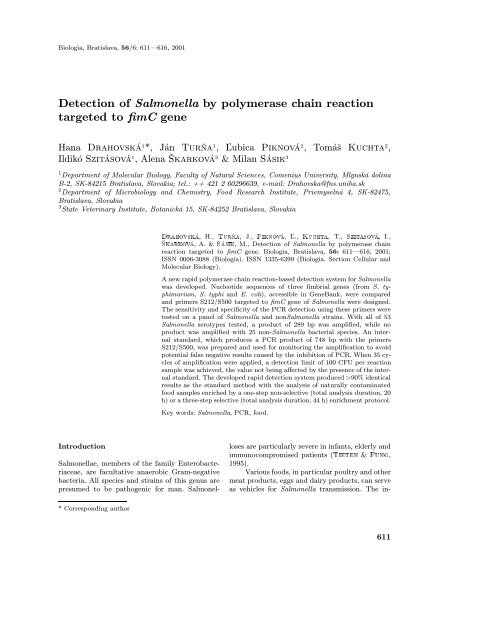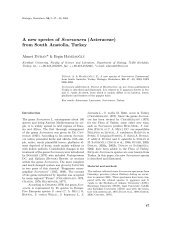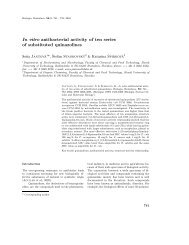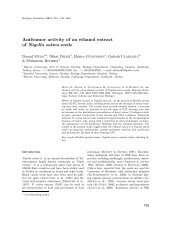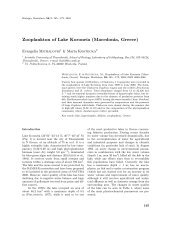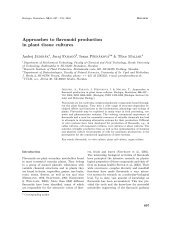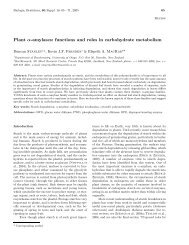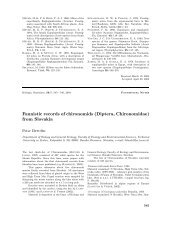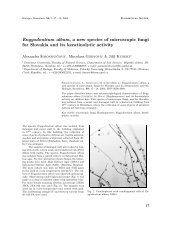Detection of Salmonella by polymerase chain reaction - Biologia ...
Detection of Salmonella by polymerase chain reaction - Biologia ...
Detection of Salmonella by polymerase chain reaction - Biologia ...
You also want an ePaper? Increase the reach of your titles
YUMPU automatically turns print PDFs into web optimized ePapers that Google loves.
<strong>Biologia</strong>, Bratislava, 56/6: 611—616, 2001<br />
<strong>Detection</strong> <strong>of</strong> <strong>Salmonella</strong> <strong>by</strong> <strong>polymerase</strong> <strong>chain</strong> <strong>reaction</strong><br />
targeted to fimC gene<br />
Hana Drahovská 1 *, Ján Turňa 1 , Ľubica Piknová 2 , Tomáš Kuchta 2 ,<br />
Ildikó Szitásová 1 ,AlenaŠkarková 3 & Milan Sásik 3<br />
1<br />
Department <strong>of</strong> Molecular Biology, Faculty <strong>of</strong> Natural Sciences, Comenius University, Mlynská dolina<br />
B-2, SK-84215 Bratislava, Slovakia; tel.: ++ 421 2 60296639, e-mail: Drahovska@fns.uniba.sk<br />
2<br />
Department <strong>of</strong> Microbiology and Chemistry, Food Research Institute, Priemyselná 4, SK-82475,<br />
Bratislava, Slovakia<br />
3<br />
State Veterinary Institute, Botanická 15, SK-84252 Bratislava, Slovakia<br />
Introduction<br />
<strong>Salmonella</strong>e, members <strong>of</strong> the family Enterobacteriaceae,<br />
are facultative anaerobic Gram-negative<br />
bacteria. All species and strains <strong>of</strong> this genus are<br />
presumed to be pathogenic for man. Salmonel-<br />
* Corresponding author<br />
Drahovská, H., Turòa, J., Piknová, Ľ., Kuchta, T., Szitasová, I.,<br />
©karková, A.&Sásik, M., <strong>Detection</strong> <strong>of</strong> <strong>Salmonella</strong> <strong>by</strong> <strong>polymerase</strong> <strong>chain</strong><br />
<strong>reaction</strong> targeted to fimC gene. <strong>Biologia</strong>, Bratislava, 56: 611—616, 2001;<br />
ISSN 0006-3088 (<strong>Biologia</strong>). ISSN 1335-6399 (<strong>Biologia</strong>. Section Cellular and<br />
Molecular Biology).<br />
A new rapid <strong>polymerase</strong> <strong>chain</strong> <strong>reaction</strong>-based detection system for <strong>Salmonella</strong><br />
was developed. Nucleotide sequences <strong>of</strong> three fimbrial genes (from S. typhimurium,<br />
S. typhi and E. coli), accessible in GeneBank, were compared<br />
and primers S212/S500 targeted to fimC gene <strong>of</strong> <strong>Salmonella</strong> were designed.<br />
The sensitivity and specificity <strong>of</strong> the PCR detection using these primers were<br />
tested on a panel <strong>of</strong> <strong>Salmonella</strong> and non<strong>Salmonella</strong> strains. With all <strong>of</strong> 53<br />
<strong>Salmonella</strong> serotypes tested, a product <strong>of</strong> 289 bp was amplified, while no<br />
product was amplified with 25 non-<strong>Salmonella</strong> bacterial species. An internal<br />
standard, which produces a PCR product <strong>of</strong> 748 bp with the primers<br />
S212/S500, was prepared and used for monitoring the amplification to avoid<br />
potential false negative results caused <strong>by</strong> the inhibition <strong>of</strong> PCR. When 35 cycles<br />
<strong>of</strong> amplification were applied, a detection limit <strong>of</strong> 100 CFU per <strong>reaction</strong><br />
sample was achieved, the value not being affected <strong>by</strong> the presence <strong>of</strong> the internal<br />
standard. The developed rapid detection system produced >90% identical<br />
results as the standard method with the analysis <strong>of</strong> naturally contaminated<br />
food samples enriched <strong>by</strong> a one-step non-selective (total analysis duration, 20<br />
h) or a three-step selective (total analysis duration, 44 h) enrichment protocol.<br />
Key words: <strong>Salmonella</strong>, PCR, food.<br />
loses are particularly severe in infants, elderly and<br />
immunocompromised patients (Tieten & Fung,<br />
1995).<br />
Various foods, in particular poultry and other<br />
meat products, eggs and dairy products, can serve<br />
as vehicles for <strong>Salmonella</strong> transmission. The in-<br />
611
crease in salmonellosis in industrialized countries<br />
over the past 35 years has accompanied the centralisation<br />
<strong>of</strong> food production and processing, despite<br />
<strong>of</strong> improvements in epidemiological and microbiological<br />
methods. Conventional methods <strong>of</strong><br />
<strong>Salmonella</strong> detection rely on enrichment in nonselective<br />
and selective broths, followed <strong>by</strong> differential<br />
agar media and serological confirmation.<br />
These methods <strong>of</strong>fer a satisfactory detection limit<br />
and specificity, but require at least 4 or 6 days<br />
to obtain negative or positive results, respectively<br />
(ISO 6579, 1993). There are consequently<br />
efforts to develop new, faster methods. <strong>Detection</strong><br />
<strong>of</strong> <strong>Salmonella</strong> <strong>by</strong>PCR,basedontheenzymatic<br />
amplification <strong>of</strong> a pre-selected region <strong>of</strong> DNA, is<br />
one such method reducing the time requirement<br />
for the analysis without a negative effect on the<br />
analytical parameters.<br />
Several PCR-based methods for the detection<br />
<strong>of</strong> <strong>Salmonella</strong> have been described. These were<br />
based on the identification <strong>of</strong> various genes, such<br />
as pathogenic determinants invA (Stone et al.,<br />
1994; Burkhalter et al., 1995), spvA (Lampel<br />
et al., 1996), iroB (Baumler et al., 1997), fimbrial<br />
genes fimA (Cohen et al., 1996) and agfA (Doran<br />
et al., 1996), genes encoding for rRNA (Iida<br />
et al., 1993) or <strong>Salmonella</strong>-specific DNA sequences<br />
with an unknown function (Aabo et al., 1993).<br />
In this work, primers were designed targeted<br />
to the fimC gene, which encodes a chaperone involved<br />
in the synthesis <strong>of</strong> type 1 fimbriae. These<br />
are proteinaceous filaments localised on the surface<br />
<strong>of</strong> the bacterial cell and are responsible for<br />
binding to specific receptors on the epithelial cell<br />
during infection. The fim operon is commonly<br />
present in members <strong>of</strong> the entire family Enterobacteriaceae,<br />
including all <strong>Salmonella</strong> serotypes (Low<br />
et al., 1996).<br />
An important feature <strong>of</strong> PCR-based methods<br />
for routine detection <strong>of</strong> pathogens should be high<br />
reproducibility and reliability. These can be improved<br />
<strong>by</strong> the application <strong>of</strong> an internal standard,<br />
which facilitates monitoring the amplification and<br />
helps to recognize false negative results caused <strong>by</strong><br />
the inhibition <strong>of</strong> PCR. For the primers designed,<br />
a mimic internal standard (Lambertz et al., 1998)<br />
was here constructed and its use optimized.<br />
To achieve satisfactory analytical parameters,<br />
food samples have to be appropriately processed<br />
prior to the detection <strong>of</strong> <strong>Salmonella</strong> <strong>by</strong><br />
PCR. Enrichment in a single non-selective medium<br />
(Manzano et al., 1998), enrichment in a nonselective<br />
medium followed <strong>by</strong> two parallel selective<br />
media (Cohen et al., 1996), and a successive enrichment<br />
in three media (Aabo et al., 1995) have<br />
612<br />
been reported to be used for this purpose. Another<br />
possibility is the use <strong>of</strong> a combination <strong>of</strong> nonselective<br />
and selective enrichment with immunomagnetic<br />
separation (Rijpens et al., 1999; Trkov<br />
et al., 1999) In this work, two enrichment protocols<br />
followed <strong>by</strong> PCR targeted to the fimC gene<br />
were compared with the standard method for the<br />
detection <strong>of</strong> <strong>Salmonella</strong> in selected naturally contaminated<br />
foods.<br />
Material and methods<br />
Bacterial strains were from the collection <strong>of</strong> Food Research<br />
Institute, Bratislava, or they were isolates from<br />
food <strong>by</strong> the State Veterinary Institute, Bratislava. Bacteria<br />
were cultured on solid or liquid Luria-Bertani<br />
(LB) media (Maniatis et al., 1982). For the determination<br />
<strong>of</strong> the detection limit, overnight cultures were<br />
serially diluted in LB broth and numbers <strong>of</strong> viable bacteria<br />
were determined <strong>by</strong> plating on LB agar.<br />
DNA preparation<br />
Chromosomal DNA was prepared according to Flamm<br />
et al. (1984). Crude lysates were prepared from 1 mL <strong>of</strong><br />
the culture grown in the liquid medium, or suspending<br />
one loopful <strong>of</strong> the culture grown on the solid medium.<br />
Bacterial cells were suspended in 1 mL <strong>of</strong> 0.8% NaCl,<br />
centrifuged at 8000 g for 10 min, and the pellet was<br />
resuspended in 1% Triton X-100. The suspension was<br />
boiled for 15 min and, after centrifugation the supernatant<br />
was used in PCR.<br />
PCR<br />
Avolume<strong>of</strong>2µL <strong>of</strong> the DNA template solution was<br />
added to 23 µL <strong>of</strong> the <strong>reaction</strong> mixture containing<br />
10 mmol/L Tris-HCl, pH 8.8, 50 mmol/L KCl, 1.5<br />
mmol/L MgCl2, 0.05% Tween 20, 200 µmol/L each<br />
dNTP, 250 nmol/L each primer, 1 U Taq DNA <strong>polymerase</strong>.<br />
Amplification was carried out in a T1 thermal<br />
cycler (Biometra, Göttingen, Germany) with a temperature<br />
programme consisting <strong>of</strong> the initial denaturation<br />
(1 min at 94 ◦ C), 35 amplification cycles (30 s at 90 ◦ C,<br />
30 s at 54 C, 60 s at 72 ◦ C), and the final extension (8<br />
min at 72 ◦ C). A volume <strong>of</strong> 10 µL <strong>of</strong> the PCR product<br />
was analysed <strong>by</strong> electrophoresis in a 1.5% agarose gel<br />
(Maniatis et al., 1982).<br />
Internal standard preparation<br />
The internal standard was produced <strong>by</strong> the method described<br />
previously (Drahovská et al., 1999). Briefly,<br />
PCR with E. coli chromosomal DNA as a template<br />
was made with the annealing temperature lowered to<br />
40 ◦ C. From several non-specific products, a fragment<br />
<strong>of</strong> about 800 bp was selected, extracted from the gel,<br />
and cloned to the pCR2.1 vector (Invitrogen).<br />
Sequencing <strong>of</strong> the PCR products<br />
Sequencing was performed <strong>by</strong> an automatic DNA sequencer<br />
(Vistra, Amersham) with individual products<br />
cloned to the pCR2.1 vector.
Table 1. Primers used in this study.<br />
primer orientation position 1 sequence<br />
S5 forward 224–262 AGCGAGCCCAAAAGTGAAA<br />
S6 reverse 665–646 GTCAATGCGCCGTAATCATT<br />
S212 forward 212–231 AAACGTTTATCGTTACGCCG<br />
S500 reverse 450–481 ATCTTGAGATGGTTGCCGAC<br />
1 In the fimC gene <strong>of</strong> S. typhimurium.<br />
Table 2. Specificity <strong>of</strong> the primer combinations. Reaction conditions were as stated in materials and methods,<br />
annealing temperature was 50 ◦ C.<br />
S212/S500 S5/S6 S212/S6 S5/S500<br />
Escherichia coli – – – –<br />
Enterobacter cloacae – – – –<br />
Citrobacter braakii – + – –<br />
Citrobacter diversus – + – –<br />
Citrobacter freundii – + – –<br />
<strong>Salmonella</strong> typhimurium + + + +<br />
<strong>Salmonella</strong> arisonae + – + –<br />
<strong>Salmonella</strong> detection in foods<br />
Food products were purchased from local retail stores.<br />
A method according to ISO 6579 (1993) was used as<br />
the reference one; all media were from Merck (Darmstadt,<br />
Germany). Samples (25 g) were homogenized in<br />
the buffered peptone water (BPW; 225 mL) and incubated<br />
at 37 ◦ C for 16 h. A volume <strong>of</strong> 0.1 mL <strong>of</strong> the<br />
culture was inoculated to 9.9 mL <strong>of</strong> the Rappaport-<br />
Vassiliadis medium, another 1 mL to 9 mL <strong>of</strong> the<br />
selenite-cystine broth, and the cultures were incubated<br />
at 41 ◦ C and at 35 ◦ C, respectively, for 7 h. Subsequently,<br />
aliquots <strong>of</strong> 1 mL were withdrawn from the<br />
selective media and subcultured in LB broth at 37 ◦ C<br />
for 16-18 h. Volumes <strong>of</strong> 1 mL <strong>of</strong> the culture in BPW,<br />
or <strong>of</strong> the two cultures in LB, were used for the lysis<br />
and PCR. For the three-step enrichment, samples<br />
were considered positive when at least one <strong>of</strong> the two<br />
LB cultures gave rise to a positive result.<br />
Results<br />
Design <strong>of</strong> the primers<br />
Three fimbrial sequences accessible in the database<br />
were compared: fimC <strong>of</strong> S. typhimurium (L19338),<br />
fimC <strong>of</strong> S. typhi (X74602), and sfmC <strong>of</strong> E. coli<br />
(AE000159). The last sequence was found to be <strong>of</strong><br />
a higher homology with fimC <strong>of</strong> <strong>Salmonella</strong> than<br />
fimC <strong>of</strong> E. coli. Based on this comparison, four<br />
primers were designed (Tab. 1). Primers S212 and<br />
S500 were selected to be <strong>Salmonella</strong>-specific, while<br />
primers S5 and S6 were conservative for all the<br />
three genes considered.<br />
Evaluation <strong>of</strong> the primers<br />
Specificity <strong>of</strong> the primers was tested on a number<br />
<strong>of</strong> bacterial strains (Tab. 2). The primer combination<br />
S212/S500 was specific for the genus<br />
<strong>Salmonella</strong> in a broad interval <strong>of</strong> annealing temperatures<br />
(46–58 ◦ C). The primer combination<br />
S5/S6 amplified a defined DNA fragment at a<br />
medium annealing temperature (50 ◦ C) not only<br />
from <strong>Salmonella</strong> spp., but from Citrobacter spp.<br />
as well. When the annealing temperature was increased<br />
to 58 ◦ C, the stringency improved and amplification<br />
took place only for <strong>Salmonella</strong> spp. On<br />
the other hand, S. arizonae was not detected with<br />
this primer combination at given <strong>reaction</strong> conditions.<br />
Based on these results, the primer combination<br />
S212/S500 was chosen for further work.<br />
Sequencing the PCR products<br />
Identity <strong>of</strong> the PCR product was confirmed <strong>by</strong><br />
sequencing. The sequence <strong>of</strong> the PCR product<br />
from S. typhimurium 34 was identical to that in<br />
the GeneBank (L19338), the sequence <strong>of</strong> the PCR<br />
product from S. enteritidis 173 differed only in one<br />
nucleotide (data not shown).<br />
Specificity <strong>of</strong> <strong>Salmonella</strong> detection<br />
The specificity <strong>of</strong> the primer pair S212/S500 was<br />
further tested on a panel <strong>of</strong> <strong>Salmonella</strong> and non-<br />
<strong>Salmonella</strong> strains. All <strong>of</strong> 53 <strong>Salmonella</strong> serotypes<br />
tested (95 strains) gave a positive signal in the<br />
PCR analysis. No product was amplified with<br />
613
Table 3. Specificity <strong>of</strong> <strong>Salmonella</strong> detection with primers S212/S500.<br />
<strong>Salmonella</strong> serotype No. <strong>of</strong> strains Result Non-salmonella species No. <strong>of</strong> strains Result<br />
S. adelaide 2 + Bacillus subtilis 1 –<br />
S. agona 1 + Citrobacter braakii 3 –<br />
S. anatum 1 + Citrobacter diversus 1 –<br />
S. arizonae 2 + Citrobacter freundii 2 –<br />
S. bareilly 1 + Citrobacter youngae 1 –<br />
S. brandenburg 2 + Citrobacter sp. 1 –<br />
S. bredeney 2 + Escherichia coli 6 –<br />
S. chester 1 + Enterobacter aglomerans 1 –<br />
S. choleraesuis 6 + Enterobacter aerogenes 1 –<br />
S. der<strong>by</strong> 2 + Enterobacter cloacae 3 –<br />
S. enteritidis 20 + Enterobacter omnigenus 1 –<br />
S. falkensee 1 + Enterococcus spp. 1 –<br />
S. florida 1 + Hafnia sp. 1 –<br />
S. gallinarium – pullorum 2 + Klebsiella pneumoniae 3 –<br />
S. gold-coast 1 + Klebsiella oxytoca 1 –<br />
S. hadar 1 + Listeria monocytogenes 1 –<br />
S. hamburg 1 + Listeria innocua 1 –<br />
S. heidelberg 1 + Proteus spp. 1 –<br />
S. infantis 5 + Pseudomonas aeruginosa 1 –<br />
S. issangii 4 + Pseudomonas sp. 1 –<br />
S. kiambu 1 + Serratia sp. 1 –<br />
S. london 1 + Shigella sp. 1 –<br />
S. luidelberg 1 + Staphylococcus sp. 1 –<br />
S. manhattan 1 + Streptococcus sp. 1 –<br />
S. montevideo 2 + Yersinia kristensenii 1 –<br />
S. newport 1 +<br />
S. ohio 3 +<br />
S. panama 1 +<br />
S. pikine 1 +<br />
S. reading 1 +<br />
S. rissen 1 +<br />
S. saint-paul 2 +<br />
S. senftenberg 1 +<br />
S. schwarzengrund 2 +<br />
S. takoradi 1 +<br />
S. tejas 1 +<br />
S. tennessee 1 +<br />
S. thompson 1 +<br />
S. typhimurium 9 +<br />
S. uganda 1 +<br />
S. virchow 4 +<br />
25 non-<strong>Salmonella</strong> bacterial species (40 strains;<br />
Tab. 3).<br />
Preparation <strong>of</strong> the internal standard<br />
To monitor the amplification using primers S212/<br />
S500, a mimic internal standard was prepared. Its<br />
use in PCR lead to the amplification <strong>of</strong> a product<br />
<strong>of</strong> 748 bp. The product was sequenced and<br />
its sequence was found to be identical with the<br />
E. coli chromosomal sequence, accession number<br />
D90823, from the nucleotide 131 to 855. The concentration<br />
<strong>of</strong> the internal standard in the <strong>reaction</strong><br />
614<br />
mixture was optimized to 10 pg (10 5 copies) <strong>of</strong><br />
the plasmid DNA. This concentration lead to a<br />
reproducible amplification if no <strong>Salmonella</strong> DNA<br />
was present while not affecting the sensitivity <strong>of</strong><br />
<strong>Salmonella</strong> detection.<br />
Sensitivity <strong>of</strong> PCR<br />
was determined with a purified DNA and with<br />
crude bacterial lysates. The detection limit was<br />
determined to be approx. 0.25 pg <strong>of</strong> the chromosomal<br />
DNA per PCR, which was equivalent to 100<br />
CFU <strong>of</strong> <strong>Salmonella</strong>. This value was not affected
in the presence <strong>of</strong> 10 6 CFU <strong>of</strong> E. coli (data not<br />
shown).<br />
<strong>Detection</strong> <strong>of</strong> <strong>Salmonella</strong> in foods<br />
The performance <strong>of</strong> the developed detection system<br />
was evaluated <strong>by</strong> the analysis <strong>of</strong> naturally<br />
contaminated food samples. Two enrichment<br />
protocols were used prior to PCR: a one-step<br />
overnight non-selective enrichment in BPW, and a<br />
three-step selective enrichment comprising a preenrichment<br />
in BPW, two parallel selective enrichments<br />
in Rappaport-Vassiliadis and selenitecystine<br />
media, respectively, and post-enrichment<br />
in LB broth. Of the 18 food samples tested, 9 were<br />
found positive <strong>by</strong> the ISO method. Identical results<br />
were obtained <strong>by</strong> the PCR detection coupled<br />
to an overnight enrichment in BPW, but one sample<br />
<strong>of</strong> chicken meat was found false negative and<br />
two samples <strong>of</strong> minced meat were found slightly<br />
false positive. PCR after a three-step enrichment<br />
produced identical results as the reference method<br />
(Tab. 4).<br />
Table 4. <strong>Detection</strong> <strong>of</strong> <strong>Salmonella</strong> in foods. Value in<br />
brackets means a slightly positive result (faint band in<br />
the electrophoresis).<br />
No. <strong>of</strong><br />
Sample type tested Positive <strong>by</strong><br />
samples<br />
PCR-BPW PCR-LB ISO 6579<br />
egg melange 5 2 2 2<br />
minced meat 8 (2) 0 0<br />
chicken meat 2 1 2 2<br />
chicken liver 1 1 1 1<br />
turkey meat 2 2 2 2<br />
Discussion<br />
The aim <strong>of</strong> the present study was to develop<br />
a rapid PCR-based system for the detection <strong>of</strong><br />
<strong>Salmonella</strong> in foods. We designed original primers<br />
S212/S500 targeted to the fimC gene, which<br />
proved to be <strong>Salmonella</strong>-specific with no crossreactivity<br />
to the other bacterial species tested.<br />
These primers were also successful in amplifying<br />
a specific DNA product from S. gallinariumpullorum<br />
although type1 fimbriae are not expressed<br />
in this serotype; this result is in agreement<br />
with the observation <strong>by</strong> Cohen et al.<br />
(1996).<br />
Sensitivity <strong>of</strong> the developed PCR, 100 CFU<br />
per <strong>reaction</strong> using a template obtained <strong>by</strong> a simple<br />
bacterial lysis was similar to that <strong>of</strong> other comparable<br />
PCR methods recommended for routine<br />
laboratories (Rijpens et al., 1999; Trkov et al.,<br />
1999). Although this might be improved <strong>by</strong> increasing<br />
the number <strong>of</strong> amplification cycles, because<br />
<strong>of</strong> the accompanying danger <strong>of</strong> false positive<br />
results caused <strong>by</strong> contamination, a combination <strong>of</strong><br />
less amplification cycles with an appropriate enrichment<br />
prior to PCR is preferred.<br />
With PCR-based detection methods, a problem<br />
<strong>of</strong> false negative results caused <strong>by</strong> inhibition<br />
may occur. Various components <strong>of</strong> food, enrichment<br />
media or DNA extraction solutions have<br />
been shown to inhibit PCR (Rossen et al., 1992).<br />
False negative results are more dangerous than the<br />
false positive ones because they may lead to contaminated<br />
samples being judged as safe. To avoid<br />
false negative results, we have prepared an internal<br />
standard, which facilitates monitoring the amplification.<br />
The application <strong>of</strong> this internal standard<br />
proved to be useful since, with the analysis <strong>of</strong> some<br />
food samples, inhibition did take place. By repeating<br />
PCR for these samples, eventual false negative<br />
results were avoided.<br />
When testing the complete detection system<br />
with naturally contaminated foods, a good agreement<br />
with the results <strong>of</strong> the standard method was<br />
observed. However, some discrepancies appeared<br />
at a one-step enrichment used prior to PCR. The<br />
two false positive samples <strong>of</strong> minced meat, which<br />
produced faint bands in PCR coupled to a one-step<br />
enrichment, but not in the standard method or<br />
when a three-step enrichment was used, were probably<br />
caused <strong>by</strong> the presence <strong>of</strong> dead <strong>Salmonella</strong><br />
cells in the food. The false negative sample <strong>of</strong><br />
chicken meat, which was negative at PCR coupled<br />
to a one-step enrichment, but positive in the standard<br />
method or when a three-step enrichment was<br />
used, was probably contaminated at a low level or<br />
<strong>by</strong> stressed <strong>Salmonella</strong> cells. When summarized,<br />
the use <strong>of</strong> a three-step enrichment prior to PCR<br />
lead to a higher agreement <strong>of</strong> the results with the<br />
standard method, but required considerably more<br />
time. For screening purposes, a one-step enrichment<br />
may be used but the problem <strong>of</strong> possible<br />
false positive an false negative results has to be<br />
kept in mind.<br />
Acknowledgements<br />
This study was supported <strong>by</strong> the Inco-Copernicus<br />
grant (No. PL979044) from EU.<br />
615
References<br />
Aabo, S.,Rasmussen, O.F.,Rossen, L.,Sorensen,<br />
P. D. & Olsen, J. E. 1993. <strong>Salmonella</strong> identification<br />
<strong>by</strong> <strong>polymerase</strong> <strong>chain</strong> <strong>reaction</strong>. Mol. Cell.<br />
Probes 7: 171–178.<br />
Aabo, S.,Andresen, J.K.&Olsen, J. E. 1995. <strong>Detection</strong><br />
<strong>of</strong> <strong>Salmonella</strong> in minced meat <strong>by</strong> the <strong>polymerase</strong><br />
<strong>chain</strong> <strong>reaction</strong> method. Lett. Appl. Microbiol.<br />
21: 180–182.<br />
Baumler, A. J., Heffron, F. & Reissbrodt, R.<br />
1997. Rapid detection <strong>of</strong> <strong>Salmonella</strong> enterica with<br />
primers specific for iroB. J. Clin. Microbiol. 35:<br />
1224–1230.<br />
Burkhalter, P.W.,Muller, C.,Luthy, J.&Candrian,<br />
U. 1995. <strong>Detection</strong> <strong>of</strong> <strong>Salmonella</strong> spp. in<br />
eggs: DNA analyses, culture techniques, and serology.<br />
J. AOAC Int. 78: 1531–1537.<br />
Cohen, H. J.,Mechanda, S. M. &Lin, W. 1996.<br />
PCR amplification <strong>of</strong> the fimA gene sequence <strong>of</strong><br />
<strong>Salmonella</strong> typhimurium, a specific method for detection<br />
<strong>of</strong> <strong>Salmonella</strong> spp. Appl. Environ. Microbiol.<br />
62: 4303–4308.<br />
Doran, J. L., Collinson, S. K., Clouther, S.<br />
C., Cebula, T. A., Koch, W. H., Burian,<br />
J., Banser, P. A., Todd, E. C. D. & Kay,<br />
W. W. 1996. Diagnostic potential <strong>of</strong> sefA DNA<br />
probes to <strong>Salmonella</strong> enteritidis and certain other<br />
O-serogroup D1 <strong>Salmonella</strong> serovars. Mol. Cell.<br />
Probes 10: 233–246.<br />
Drahovská,H.,Turòa, J.,Boháèová,V.,Piknová,<br />
Ľ., Kuchta, T. 1999. Príprava a použitie vnútorného<br />
štandardu pri dôkaze salmonel polymerázovou<br />
reťazovou reakciou. Bull. Potr. Výskumu 38:<br />
95–102.<br />
Flamm, R.K.,Hinrichs, D.J.&Thomashow, M.<br />
F.1984. Introduction <strong>of</strong> pAM beta 1 into Listeria<br />
monocytogenes <strong>by</strong> conjugation and homology between<br />
native L. monocytogenes plasmids. Infect.<br />
Immun. 44: 157–161.<br />
Iida, K.,Abe, A.,Matsui, H.,Danbara, H.,Wakayama,<br />
S.&Kawahara, K. 1993. Rapid and sensitive<br />
method for detection <strong>of</strong> <strong>Salmonella</strong> strains<br />
using combination <strong>of</strong> PCR and reverse dot-blot hybridization.<br />
FEMS Microbiol. Lett. 114: 167–172.<br />
ISO 6579. 1993. Microbiology: General guidance on<br />
methods for the detection <strong>of</strong> <strong>Salmonella</strong>, 3rd<br />
ed. International Organization for Standardization,<br />
Geneva.<br />
616<br />
Lambertz,S.T,Ballagi-Pordany,A.&Lindquist,<br />
R. 1998. A mimic as internal standard to monitor<br />
PCR analysis <strong>of</strong> food-borne pathogens. Lett. Appl.<br />
Microbiol. 26: 9–11.<br />
Lampel, K.A.,Keasler, S.P.&Hanes, D. E. 1996.<br />
Specific detection <strong>of</strong> <strong>Salmonella</strong> enterica serotype<br />
Enteritidis using the <strong>polymerase</strong> <strong>chain</strong> <strong>reaction</strong>.<br />
Epidemiol. Infect. 116: 137–145.<br />
Low, D., Braaten, B. & Van Der Woude, M.<br />
1996. Fimbriae, pp. 146–157. In: Neidhardt,<br />
C. F. (ed) Escherichia coli and <strong>Salmonella</strong> typhimurium,<br />
Cellular and Molecular Biology, 2nd<br />
Edition. ASM Press, Washington.<br />
Maniatis, T.,Fritsch, E.F.&Sambrook, J. 1982.<br />
Molecular Cloning. Cold Spring Harbor Laboratory,<br />
New York, 545 pp.<br />
Manzano, M.,Cocolin, L.,Astori, G.,Pipan, C.,<br />
Botta, G.A.,Cantoni, C.&Comi, G. 1998. Development<br />
<strong>of</strong> a PCR microplate-capture hybridization<br />
method for simple, fast and sensitive detection<br />
<strong>of</strong> <strong>Salmonella</strong> serovars in food. Mol. Cell. Probes<br />
12: 227–234.<br />
Rijpens, N.,Herman, L.,Vereecken, F.,Jannes,<br />
G., De Smedt, J.&De Zutter, L. 1999. Rapid<br />
detection <strong>of</strong> stressed <strong>Salmonella</strong> spp. in dairy and<br />
egg products using immunomagnetic separation<br />
and PCR. Int. J. Food Microbiol. 46: 37–44.<br />
Rossen, L.,Norskov, P.,Holmstrom, K.&Rasmussen,<br />
O. F. 1992 Inhibition <strong>of</strong> PCR <strong>by</strong> components<br />
<strong>of</strong> food samples, microbial diagnostic assays<br />
and DNA extraction solutions. Int. J. Food Microbiol.<br />
17: 37–45.<br />
Stone, G.G.,Oberst, R.D.,Hays, M.P.,McVey,<br />
S. & Chengappa, M. M. 1994. <strong>Detection</strong> <strong>of</strong><br />
<strong>Salmonella</strong> serovars from clinical samples <strong>by</strong> enrichment<br />
broth cultivation – PCR procedure. J.<br />
Clin. Microbiol. 32: 1742–1749.<br />
Tieten, M.&Fung, D. Y. C. 1995. <strong>Salmonella</strong>e and<br />
food safety. Crit. Rev. Microbiol. 21: 53–83.<br />
Trkov, M.,Majeríková, I.,Jer¹ek, B.,©tefanovièová,<br />
A.,Rijpens, N.&Kuchta, T. 1999. <strong>Detection</strong><br />
<strong>of</strong> <strong>Salmonella</strong> in food over 30 h using enrichment<br />
and <strong>polymerase</strong> <strong>chain</strong> <strong>reaction</strong>. Food Microbiol.<br />
16: 393–399.<br />
Received December 12, 2000<br />
Accepted September 3, 2001


